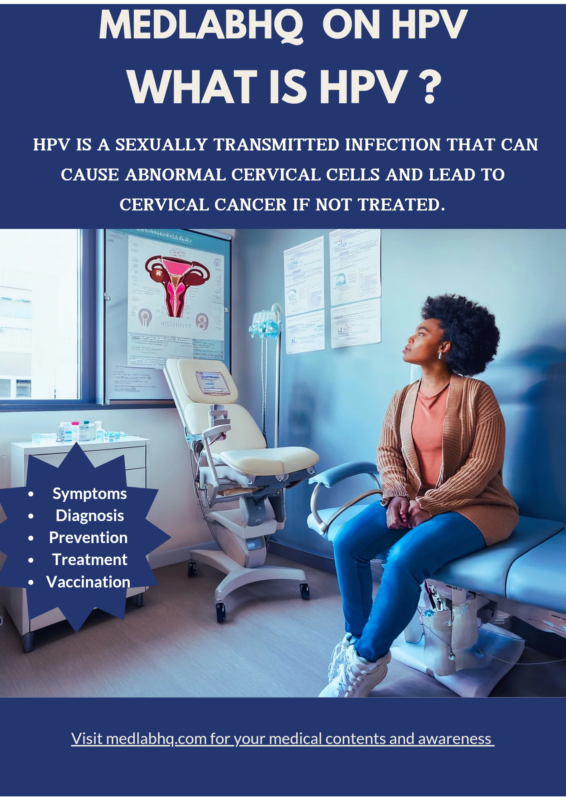Table of Contents
HPV (Human Papilloma virus)
HPV refers to a group of viruses, with over 200 types identified, of which about 40 can infect the genital area. It is a double stranded DNA virus that causes cellular changes to epithelial cells. HPV is transmitted from one person to another via sexual contacts; including and not subjected to skin to skin, body fluid exchange. And no, condoms offer no consistent protection against Human papilloma virus.
Disease conditions associated with HPV
- Sexually transmitted infection (STI):
HPV is the most common cause of STI, and also the chief cause of warts in various parts of the body, depending on the strain. Although, many individuals infected with human papillomavirus (HPV) remain asymptomatic, they can still transmit the virus through sexual contact.
It’s important to note that HPV infections are widespread, with a majority of sexually active people encountering the virus at some point. Fortunately, most infections are transient, as the immune system naturally clears the virus without requiring specific intervention.
- Cervical Cancer:
The presence of some strains of HPV notably HPV 16 and HPV 18 amongst others, are linked to cervical cancer and other cancers like those of the anus, penis, throat, and vulva. These HPV types can cause cellular changes in the cervix that may, over time, progress to cancer if left untreated.
The goal is to detect the precancerous cells before they fully develop into cancer, because unfortunately, there is no cure for HPV.
Common symptoms of HPV
Symptom include the development of warts on the genital area or nearby skin, in some cases, the warts may resolve on their own. However, there are more asymptomatic carriers and there lies the high potention of HPV transmission.
HPV laboratory Diagnosis
HPV cannot be detected using the traditional methods of viral screening (serology, culture).
The most common method for HPV test is PCR.
The following steps are necessary for an accurate HPV screening.
- Patient Preparation: Patients are to avoid activities that will compromise the cells of the cervix days before the test.
- Sample collection : Pap smear (conventional & liquid based cytology).
- Sample processing: The sample may be processed as a liquid-based cytology or conventional smear, depending on the method used.
- DNA Extraction: DNA is extracted from the cervical cells using specific extraction kits.
- HPV Testing : Nucleic Acid Testing (NAT) and Genotyping to ascertain presence or absence of High-risk HPV types.
However, depending on the clinical presentations and preliminary test results other indirect methods can be employed.
Other Screening Methods for HPV (indirect)
- COLPOSCOPY (examination of the cervix, vagina and vulva after acetic acid application)
- BIOPSY (During colposcopy, biopsy of abnormal tissues is carried out)
- Other methods of DNA hybridization
Treatment
There is currently no treatment for HPV infection. However, Treatments can be done for genital warts, cervical precancers and cervical cancer.
Early treatment options for HPV-related precancerous lesions include:
- Cryotherapy: Freezing abnormal cells to destroy them.
- Laser therapy: Using a laser beam to remove abnormal cells.
- Loop electrosurgical excision procedure (LEEP): Using a wire loop heated by an electric current to remove abnormal cells.
- Conization: Removing a cone-shaped piece of tissue from the cervix that contains abnormal cells.
Regular HPV screening is advised, as early detection leads to early treatment, which is important in preventing cervical cancer and other HPV-related diseases.
When HPV is detected early through screening tests like the Pap smear and HPV test, precancerous changes can be identified and monitored or treated before they progress to cancer.
These treatments have success rate of 90%. And remember, that HPV can clear on their own and not all precancerous changes progress to cancer.
The Idea is to follow up with your healthcare provider regularly for early interventions.
Prevention of HPV
To prevent HPV infections and related complications, such as genital warts and cervical cancer; vaccination is recommended for both boys and girls.
Regular HPV screening, as early detection leads to early
Who should receive vaccination?
The HPV vaccine is recommended for several key groups to maximize its effectiveness in preventing cervical cancer and other HPV-related diseases:
- Children Aged 12 to 13: The vaccine is routinely offered to children in this age group, ideally before they become sexually active, to ensure optimal immunity.
- Young Adults: Individuals up to age 26 who missed the vaccine during their early teenage years are encouraged to get vaccinated.
- Men Under 45 Who Have Sex with Men: This group is at higher risk for HPV-related diseases and can receive the vaccine if they attend sexual health or HIV clinics.
- Individuals at Higher Risk: This includes transgender individuals with similar risk profiles as men who have sex with men, sex workers, and people living with HIV.
- Catch-Up Vaccination: Those under 25 years who missed vaccination during school years are eligible for free vaccination in many health systems.
The vaccine is most effective when administered before exposure to HPV, reinforcing the importance of early vaccination programs
Reference
- https://www.who.int/news-room/fact-sheets/detail/human-papilloma-virus-and-cancer
- https://www.cdc.gov/vaccines/vpd/hpv/hcp/vaccines.html
- https://www.nhs.uk/vaccinations/hpv-vaccine/


nice article. educative indeed.
This has reminded me of one of my university lectures!
down memory lane